The Tale of Genji
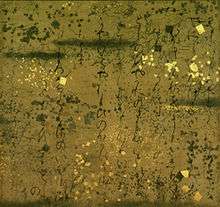 Written text from the earliest illustrated handscroll (12th century) | |
| Author | Murasaki Shikibu |
|---|---|
| Original title |
源氏物語 Genji Monogatari |
| Translator | Suematsu Kenchō, Arthur Waley, Edward G. Seidensticker, Helen McCullough, Royall Tyler, Dennis Washburn |
| Country | Japan |
| Language | Early Middle Japanese |
| Genre | Monogatari |
| Published | Before 1021 |
| Media type | manuscript |
| 895.63 M93 | |
The Tale of Genji (源氏物語 Genji monogatari) is a classic work of Japanese literature written by the noblewoman and lady-in-waiting Murasaki Shikibu in the early years of the 11th century. The original manuscript no longer exists. It was made in "concertina" or "orihon" style[1]: several sheets of paper pasted together and folded alternately in one direction then the other, around the peak of the Heian period. The work is a unique depiction of the lifestyles of high courtiers during the Heian period, written in archaic language and a poetic and confusing style that make it unreadable to the average Japanese without dedicated study.[2] It was not until the early 20th century that Genji was translated into modern Japanese, by the poet Akiko Yosano. The first English translation was attempted in 1882, but was of poor quality and incomplete.
The work recounts the life of Hikaru Genji, or "Shining Genji", the son of an ancient Japanese emperor, known to readers as Emperor Kiritsubo, and a low-ranking concubine called Kiritsubo Consort. For political reasons, the emperor removes Genji from the line of succession, demoting him to a commoner by giving him the surname Minamoto, and he pursues a career as an imperial officer. The tale concentrates on Genji's romantic life and describes the customs of the aristocratic society of the time. It is sometimes called the world's first novel, the first modern novel, the first psychological novel or the first novel still to be considered a classic. While regarded as a masterpiece, its precise classification and influence in both the Western and Eastern canons has been a matter of debate.
Historical context
The Tale of Genji may have been written chapter by chapter in installments, as Murasaki delivered the tale to aristocratic women (the nyokan). It has many elements found in a modern novel: a central character and a very large number of major and minor characters, well-developed characterization of all the major players, a sequence of events covering the central character's lifetime and beyond. The work does not make use of a plot; instead, events happen and characters simply grow older. One remarkable feature of the Genji, and of Murasaki's skill, is its internal consistency, despite a dramatis personæ of some four hundred characters. For instance, all characters age in step and the family and feudal relationships maintain general consistency.
One complication for readers and translators of the Genji is that almost none of the characters in the original text are given explicit names. The characters are instead referred to by their function or role (e.g. Minister of the Left), an honorific (e.g. His Excellency), or their relation to other characters (e.g. Heir Apparent), which changes as the novel progresses. This lack of names stems from Heian-era court manners that would have made it unacceptably familiar and blunt to freely mention a person's given name. Modern readers and translators have used various nicknames to keep track of the many characters.
The Tale of Genji was written in an archaic court language that was already unreadable a century after it was written.[3] Thus, the Japanese have been reading annotated and illustrated versions of the work since as early as the 12th century.[3] It was not until the early 20th century that Genji was translated into modern Japanese, by the poet Akiko Yosano.[4]
Authorship
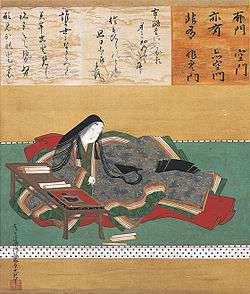
The debate over how much of Genji was actually written by Murasaki Shikibu has gone on for centuries and is unlikely to ever be settled unless some major archival discovery is made. It is generally accepted that the tale was finished in its present form by 1021, when the author of the Sarashina Nikki wrote a diary entry about her joy at acquiring a complete copy of the tale. She writes that there are over 50 chapters and mentions a character introduced at the end of the work, so if other authors besides Murasaki Shikibu did work on the tale, the work was done very near to the time of her writing. Murasaki Shikibu's own diary includes a reference to the tale, and indeed the application to herself of the name 'Murasaki' in an allusion to the main female character. That entry confirms that some if not all of the diary was available in 1008 when internal evidence suggests convincingly that the entry was written.[5]
Lady Murasaki is said to have written the character of Genji based on the Minister on the Left at the time she was at court. Other translators, such as Tyler, believe the character Murasaki no Ue, whom Genji marries, is based on Murasaki Shikibu herself.
Yosano Akiko, the first author to make a modern Japanese translation of Genji, believed that Murasaki Shikibu had only written chapters 1 to 33, and that chapters 35 to 54 were written by her daughter Daini no Sanmi.[6] Other scholars have also doubted the authorship of chapters 42 to 54 (particularly 44, which contains rare examples of continuity mistakes).[6] According to Royall Tyler's introduction to his English translation of the work, recent computer analysis has turned up "statistically significant" discrepancies of style between chapters 45–54 and the rest, and also among the early chapters.[6]
Plot


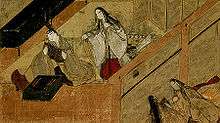
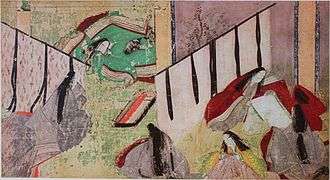
The work recounts the life of Hikaru Genji, or "Shining Genji", the son of an ancient Japanese emperor, known to readers as Emperor Kiritsubo, and a low-ranking, but beloved concubine called Kiritsubo Consort. For political reasons, the emperor removes Genji from the line of succession, demoting him to a commoner by giving him the surname Minamoto, and he pursues a career as an imperial officer. The tale concentrates on Genji's romantic life and describes the customs of the aristocratic society of the time.
Genji's mother dies when he is three years old, and the Emperor cannot forget her. The Emperor Kiritsubo then hears of a woman (Lady Fujitsubo), formerly a princess of the preceding emperor, who resembles his deceased concubine, and later she becomes one of his wives. Genji loves her first as a stepmother, but later as a woman, and they fall in love with each other. Genji is frustrated by his forbidden love for the Lady Fujitsubo and is on bad terms with his wife (Aoi no Ue). He engages in a series of unfulfilling love affairs with other women, but in most cases his advances are rebuffed, his lover dies suddenly during the affair, or he becomes bored with his lover.
Genji visits Kitayama, the northern rural hilly area of Kyoto, where he finds a beautiful ten-year-old girl. He is fascinated by this little girl (Murasaki), and discovers that she is a niece of the Lady Fujitsubo. Finally he kidnaps her, brings her to his own palace and educates her to be his ideal lady — that is, like the Lady Fujitsubo. During this time Genji also meets the Lady Fujitsubo secretly, and she bears his son, Reizei. Everyone except the two lovers believes the father of the child is the Emperor Kiritsubo. Later, the boy becomes the Crown Prince and Lady Fujitsubo becomes the Empress, but Genji and Lady Fujitsubo swear to keep their secret.
Genji and his wife, Lady Aoi, reconcile. She gives birth to a son but dies soon after. Genji is sorrowful, but finds consolation in Murasaki, whom he marries. Genji's father, the Emperor Kiritsubo, dies. He is succeeded by his son Suzaku, whose mother (Kokiden), together with Kiritsubo's political enemies, takes power in the court. Then another of Genji's secret love affairs is exposed: Genji and a concubine of the Emperor Suzaku are discovered when they meet in secret. The Emperor Suzaku confides his personal amusement at Genji's exploits with the woman (Oborozukiyo), but is duty-bound to punish his half-brother. He exiles Genji to the town of Suma in rural Harima Province (now part of Kobe in Hyōgo Prefecture). There, a prosperous man known as the Akashi Novice (because he is from Akashi in Settsu Province) entertains Genji, and Genji has a love affair with Akashi's daughter. She gives birth to Genji's only daughter, who will later become the Empress.
In the capital, the Emperor Suzaku is troubled by dreams of his late father, Kiritsubo, and something begins to affect his eyes. Meanwhile, his mother, Kokiden, grows ill, which weakens her powerful sway over the throne. Thus the Emperor orders Genji pardoned, and he returns to Kyoto. His son by Lady Fujitsubo, Reizei, becomes the emperor. The new Emperor Reizei knows Genji is his real father, and raises Genji's rank to the highest possible.
However, when Genji turns 40 years old, his life begins to decline. His political status does not change, but his love and emotional life are slowly damaged. He marries another wife, the Third Princess (known as Onna san no miya in the Seidensticker version, or Nyōsan in Waley's). Genji's nephew, Kashiwagi, later forces himself on the Third Princess, and she bears Kaoru (who, in a similar situation to that of Reizei, is legally known as the son of Genji). Genji's new marriage changes his relationship with Murasaki, who becomes a nun (bikuni).
Genji's beloved Murasaki dies. In the following chapter, Maboroshi ("Illusion"), Genji contemplates how fleeting life is. Immediately after Maboroshi, there is a chapter entitled Kumogakure ("Vanished into the Clouds"), which is left blank, but implies the death of Genji.
The rest of the work is known as the "Uji Chapters". These chapters follow Kaoru and his best friend, Niou. Niou is an imperial prince, the son of Genji's daughter, the current Empress now that Reizei has abdicated the throne, while Kaoru is known to the world as Genji's son but is in fact fathered by Genji's nephew. The chapters involve Kaoru and Niou's rivalry over several daughters of an imperial prince who lives in Uji, a place some distance away from the capital. The tale ends abruptly, with Kaoru wondering if Niou is hiding the lady the former loves away from him. Kaoru has sometimes been called the first anti-hero in literature.[7]
Completion
The tale has an abrupt ending. Opinions vary on whether the ending was the intended ending of the author. Arthur Waley, who made the first English translation of the whole of The Tale of Genji, believed that the work as we have it was finished. Ivan Morris, author of The World of the Shining Prince, believed that it was not complete, with later chapters missing. Edward Seidensticker, who made the second translation of the Genji, believed that it was not finished, and that Murasaki Shikibu would not have had a planned story structure with an "ending", and would simply have gone on writing as long as she could.
Literary context
Because it was written to entertain the Japanese court of the eleventh century, the work presents many difficulties to modern readers. First and foremost, Murasaki's language, Heian period court Japanese, was highly inflected and had very complex grammar. Another problem is that naming people was considered rude in Heian court society, so none of the characters are named within the work; instead, the narrator refers to men often by their rank or their station in life, and to women often by the color of their clothing, or by the words used at a meeting, or by the rank of a prominent male relative. This results in different appellations for the same character depending on the chapter.
Another aspect of the language is the importance of using poetry in conversations. Modifying or rephrasing a classic poem according to the current situation was expected behavior in Heian court life, and often served to communicate thinly veiled allusions. The poems in the Genji are often in the classic Japanese tanka form. Many of the poems were well known to the intended audience, so usually only the first few lines are given and the reader is supposed to complete the thought themselves, much like today we could say "when in Rome ..." and leave the rest of the saying ("... do as the Romans do") unspoken.[8]
As with most Heian literature, the Genji was probably written mostly (or perhaps entirely) in kana (Japanese phonetic script) and not in Chinese characters because it was written by a woman for a female audience. Writing in Chinese characters was at the time a masculine pursuit; women were generally discreet when using Chinese symbols, confining themselves mostly to native Japanese words (yamato kotoba).
Outside of vocabulary related to politics and Buddhism, the Genji contains remarkably few Chinese loan words (kango). This has the effect of giving the story a very even, smooth flow. However, it also introduces confusion: there are a number of homophones (words with the same pronunciation but different meanings), and for modern readers, context is not always sufficient to determine which meaning was intended.
Structure
The novel is traditionally divided in three parts, the first two dealing with the life of Genji, and the last dealing with the early years of two of Genji's prominent descendants, Niou and Kaoru. There are also several short transitional chapters which are usually grouped separately and whose authorship is sometimes questioned.
- Genji's rise and fall
- Youth, chapters 1–33: Love, romance, and exile
- Success and setbacks, chapters 34–41: A taste of power and the death of his beloved wife
- The transition (chapters 42–44): Very short episodes following Genji's death
- Uji, chapters 45–54: Genji's official and secret descendants, Niou and Kaoru
The 54th and last chapter "The Floating Bridge of Dreams" is sometimes argued to be a separate part from the Uji part by modern scholars. It seems to continue the story from the previous chapters, but has an unusually abstract chapter title. It is the only chapter whose title has no clear reference within the text, but this may be because the chapter is unfinished. This question is more difficult because we do not know exactly when the chapters acquired their titles.
List of chapters
The English translations here are taken from the Arthur Waley, the Edward Seidensticker, the Royall Tyler (academic), and the Dennis Washburn translations. The first column refers to Waley's translation, the second to Seidensticker's, the third to Tyler's, and the fourth to Washburn's. It is not known for certain when the chapters acquired their titles. Early mentions of the Tale refer to chapter numbers, or contain alternate titles for some of the chapters. This may suggest that the titles were added later. The titles are largely derived from poetry that is quoted within the text, or allusions to various characters.
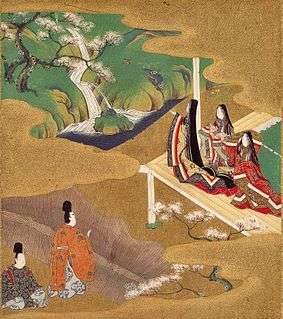
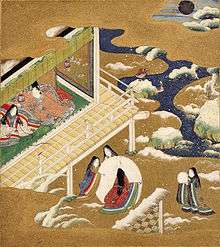
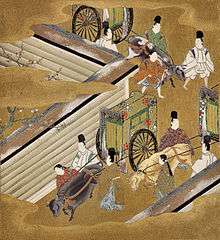

| Chapter | Japanese | Waley | Seidensticker | Tyler | Washburn |
|---|---|---|---|---|---|
| 01 | Kiritsubo (桐壺) | "Kiritsubo" | "The Paulownia Court" | "The Paulownia Pavilion" | "The Lady of the Paulownia-Courtyard Chambers" |
| 02 | Hahakigi (帚木) | "The Broom-Tree" | "Broom Cypress" | ||
| 03 | Utsusemi (空蝉) | "Utsusemi" | "The Shell of the Locust" | "The Cicada Shell" | "A Molted Cicada Shell" |
| 04 | Yūgao (夕顔) | "Yugao" | "Evening Faces" | "The Twilight Beauty" | "The Lady of the Evening Faces" |
| 05 | Wakamurasaki (若紫) | "Murasaki" | "Lavender" | "Young Murasaki" | "Little Purple Gromwell" |
| 06 | Suetsumuhana (末摘花) | "The Saffron-Flower" | "The Safflower" | ||
| 07 | Momiji no Ga (紅葉賀) | "The Festival of Red Leaves" | "An Autumn Excursion" | "Beneath the Autumn Leaves" | "An Imperial Celebration of Autumn Foliages" |
| 08 | Hana no En (花宴) | "The Flower Feast" | "The Festival of the Cherry Blossoms" | "Under the Cherry Blossoms" | "A Banquet Celebrating Cherry Blossoms" |
| 09 | Aoi (葵) | "Aoi" | "Heartvine" | "Heart-to-Heart" | "Leaves of Wild Ginger" |
| 10 | Sakaki (榊) | "The Sacred Tree" | "The Green Branch" | "A Branch of Sacred Evergreens" | |
| 11 | Hana Chiru Sato (花散里) | "The Village of Falling Flowers" | "The Orange Blossoms" | "Falling Flowers" | "The Lady at the Villa of Scattering Orange Blossoms" |
| 12 | Suma (須磨) | "Exile at Suma" | "Suma" | "Exile to Suma" | |
| 13 | Akashi (明石) | "Akashi" | "The Lady at Akashi" | ||
| 14 | Miotsukushi (澪標) | "The Flood Gauge" | "Channel Buoys" | "The Pilgrimage to Sumiyoshi" | "Channel Markers" |
| 15 | Yomogiu (蓬生) | "The Palace in the Tangled Woods" | "The Wormwood Patch" | "A Waste of Weeds" | "A Ruined Villa of Tangled Gardens" |
| 16 | Sekiya (関屋) | "A Meeting at the Frontier" | "The Gatehouse" | "At the Pass" | "The Barrier Gate" |
| 17 | E Awase (絵合) | "The Picture Competition" | "A Picture Contest" | "The Picture Contest" | "A Contest of Illustrations" |
| 18 | Matsukaze (松風) | "The Wind in the Pine-Trees" | "The Wind in the Pines" | "Wind in the Pines" | |
| 19 | Usugumo (薄雲) | "A Wreath of Cloud" | "A Rack of Clouds" | "Wisps of Cloud" | "A Thin Veil of Clouds" |
| 20 | Asagao (朝顔) | "Asagao" | "The Morning Glory" | "The Bluebell" | "Bellflowers" |
| 21 | Otome (乙女) | "The Maiden" | "The Maidens" | "Maidens of the Dance" | |
| 22 | Tamakazura (玉鬘) | "Tamakatsura" | "The Jewelled Chaplet" | "The Tendril Wreath" | "A Lovely Garland" |
| 23 | Hatsune (初音) | "The First Song of the Year" | "The First Warbler" | "The Warbler's First Song" | "First Song of Spring" |
| 24 | Kochō (胡蝶) | "The Butterflies" | "Butterflies" | ||
| 25 | Hotaru (螢) | "The Glow-Worm" | "Fireflies" | "The Fireflies" | "Fireflies" |
| 26 | Tokonatsu (常夏) | "A Bed of Carnations" | "Wild Carnation" | "The Pink" | "Wild Pinks" |
| 27 | Kagaribi (篝火) | "The Flares" | "Flares" | "The Cressets" | "Cresset Fires" |
| 28 | Nowaki (野分) | "The Typhoon" | "An Autumn Tempest" | ||
| 29 | Miyuki (行幸) | "The Royal Visit" | "The Royal Outing" | "The Imperial Progress" | "An Imperial Excursion" |
| 30 | Fujibakama (藤袴) | "Blue Trousers" | "Purple Trousers" | "Thoroughwort Flowers" | "Mistflowers" |
| 31 | Makibashira (真木柱) | "Makibashira" | "The Cypress Pillar" | "The Handsome Pillar" | "A Beloved Pillar of Cypress" |
| 32 | Umegae (梅枝) | "The Spray of Plum-Blossom" | "A Branch of Plum" | "The Plum Tree Branch" | "A Branch of Plum" |
| 33 | Fuji no Uraba (藤裏葉) | "Fuji no Uraba" | "Wisteria Leaves" | "New Wisteria Leaves" | "Shoots of Wisteria Leaves" |
| 34 | Wakana: Jō (若菜上) | "Wakana, Part I" | "New Herbs, Part I" | "Spring Shoots I" | "Early Spring Genesis: Part 1" |
| 35 | Wakana: Ge (若菜下) | "Wakana, Part II" | "New Herbs, Part II" | "Spring Shoots II" | "Early Spring Genesis: Part 2" |
| 36 | Kashiwagi (柏木) | "Kashiwagi" | "The Oak Tree" | ||
| 37 | Yokobue (横笛) | "The Flute" | "The Transverse Flute" | ||
| 38 | Suzumushi (鈴虫) | (not translated) | "The Bell Cricket" | "Bell Crickets" | |
| 39 | Yūgiri (夕霧) | "Yugiri" | "Evening Mist" | ||
| 40 | Minori (御法) | "The Law" | "Rites" | "The Law" | "Rites of Sacred Law" |
| 41 | Maboroshi (幻) | "Mirage" | "The Wizard" | "The Seer" | "Spirit Summoner" |
| X | Kumogakure (雲隠) | "Vanished into the Clouds" | |||
| 42 | Niō Miya (匂宮) | "Niou" | "His Perfumed Highness" | "The Perfumed Prince" | "The Fragrant Prince" |
| 43 | Kōbai (紅梅) | "Kobai" | "The Rose Plum" | "Red Plum Blossoms" | "Red Plum" |
| 44 | Takekawa (竹河) | "Bamboo River" | |||
| 45 | Hashihime (橋姫) | "The Bridge Maiden" | "The Lady at the Bridge" | "The Maiden of the Bridge" | "The Divine Princess at Uji Bridge" |
| 46 | Shī ga Moto (椎本) | "At the Foot of the Oak-Tree" | "Beneath the Oak" | "At the Foot of the Oak Tree" | |
| 47 | Agemaki (総角) | "Agemaki" | "Trefoil Knots" | "A Bowknot Tied in Maiden's Loops" | |
| 48 | Sawarabi (早蕨) | "Fern-Shoots" | "Early Ferns" | "Bracken Shoots" | "Early Fiddlehead Greens" |
| 49 | Yadorigi (宿木) | "The Mistletoe" | "The Ivy" | "Trees Encoiled in Vines of Ivy" | |
| 50 | Azumaya (東屋) | "The Eastern House" | "The Eastern Cottage" | "A Hut in the Eastern Provinces" | |
| 51 | Ukifune (浮舟) | "Ukifune" | "A Boat upon the Waters" | "A Drifting Boat" | "A Boat Cast Adrift" |
| 52 | Kagerō (蜻蛉) | "The Gossamer-Fly" | "The Drake Fly" | "The Mayfly" | "Ephemerids" |
| 53 | Tenarai (手習) | "Writing-Practice" | "The Writing Practice" | "Writing Practice" | "Practising Calligraphy" |
| 54 | Yume no Ukihashi (夢浮橋) | "The Bridge of Dreams" | "The Floating Bridge of Dreams" | "A Floating Bridge in a Dream" | |
The additional chapter between 41 and 42 in some manuscripts is called 雲隠 (Kumogakure) which means "Vanished into the Clouds" — the chapter is a title only, and is probably intended to evoke Genji's death. Some scholars have posited the existence of a chapter between 1 and 2 which is now lost, which would have introduced some characters that (as it stands now) appear very abruptly.
The Waley translation completely omits the 38th chapter.
Later authors have composed additional chapters, most often either between 41 and 42, or after the end.
Manuscripts
The original manuscript written by Murasaki Shikibu no longer exists. Numerous copies, totaling around 300 according to Ikeda Kikan, exist with differences between each. It is thought that Shikibu often went back and edited early manuscripts introducing discrepancies with earlier copies.[9]
The various manuscripts are classified into three categories:[10][11]
- Kawachibon (河内本)
- Aobyōshibon (青表紙本)
- Beppon (別本)
In the 13th century, two major attempts by Minamoto no Chikayuki and Fujiwara Teika were made to edit and revise the differing manuscripts. The Chikayuki manuscript is known as the Kawachibon; edits were many beginning in 1236 and completing in 1255. The Teika manuscript is known as the Aobyōshibon; its edits are more conservative and thought to better represent the original. These two manuscripts were used as the basis for many future copies.
The Beppon category represents all other manuscripts not belonging to either Kawachibon or Aobyōshibon. This includes older but incomplete manuscripts, mixed manuscripts derived from both Kawachibon and Aobyōshibon, and commentaries.
On March 10, 2008, it was announced that a late Kamakura period manuscript was found in Kyōto.[12][13] It is the sixth chapter "Suetsumuhana" and is 65 pages in length. Most remaining manuscripts are based on copies of the Teika manuscript which introduced revisions in the original. This newly discovered manuscript belongs to a different lineage and was not influenced by Teika. Professor Yamamoto Tokurō, who examined the manuscript said, "This is a precious discovery as Kamakura manuscripts are so rare." Professor Katō Yōsuke said, "This is an important discovery as it asserts that non-Teika manuscripts were being read during the Kamakura period."
On October 29, 2008, Konan Women's University announced that a mid-Kamakura period manuscript was found.[14][15][16] It is the 32nd chapter, Umegae, and is recognized as the oldest extant copy of this chapter dating between 1240–80. This beppon manuscript is 74 pages in length and differs from Aobyōshi manuscripts in at least four places, raising the "possibility that the contents may be closer to the undiscovered Murasaki Shikibu original manuscript".[14]
Illustrated scroll

A twelfth-century scroll, the Genji monogatari emaki, contains illustrated scenes from the Genji together with handwritten sōgana text. This scroll is the earliest extant example of a Japanese "picture scroll": collected illustrations and calligraphy of a single work. The original scroll is believed to have comprised 10-20 rolls and covered all 54 chapters. The extant pieces include only 19 illustrations and 65 pages of text, plus nine pages of fragments. This is estimated at roughly 15% of the envisioned original. The Tokugawa Art Museum in Nagoya has three of the scrolls handed down in the Owari branch of the Tokugawa clan and one scroll held by the Hachisuka family is now in the Gotoh Museum in Tokyo. The scrolls are designated National Treasures of Japan. The scrolls are so fragile that they normally are not shown in public. The original scrolls in the Tokugawa Museum were shown from November 21 to November 29 in 2009. Since Heisei 13, they have been displayed in the Tokugawa Museum always for around one week in November. An oversize English photoreproduction and translation was printed in limited edition by Kodansha International (Tale of Genji Scroll, ISBN 0-87011-131-0).
Other notable versions are by Tosa Mitsuoki, who lived from 1617 to 1691. His paintings are closely based on Heian style from the existing scrolls from the 12th century and are fully complete. The tale was also a popular theme in Ukiyo-e prints from the Edo period.
Modern readership
Japanese
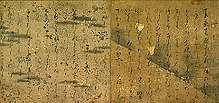
The complexities of the style mentioned in the previous section make it unreadable by the average Japanese person without dedicated study of the language of the tale. Therefore, translations into modern Japanese and other languages solve these problems by modernizing the language, unfortunately losing some of the meaning, and by giving names to the characters, usually the traditional names used by academics. This gives rise to anachronisms; for instance Genji's first wife is named Aoi because she is known as the lady of the Aoi chapter, in which she dies.
Both scholars and writers have tried translating it. The first translation into modern Japanese was made by the poet Yosano Akiko. Other known translations were done by the novelists Jun'ichirō Tanizaki and Fumiko Enchi.
Because of the cultural differences, reading an annotated version of the Genji is quite common, even among Japanese. There are several annotated versions by novelists, including Seiko Tanabe, Jakucho Setouchi and Osamu Hashimoto.[17] Many works, including a manga series and different television dramas, are derived from The Tale of Genji. There have been at least five manga adaptations of the Genji.[18] A manga version by Waki Yamato, Asakiyumemishi (The Tale of Genji in English), is widely read among Japanese youth, and another version, by Miyako Maki, won the Shogakukan Manga Award in 1989.[19]
Most Japanese high-school students read selections of the Genji (the original, not a translation) in their Japanese classes.
English translations
The first partial translation of Genji Monogatari into English was by Suematsu Kenchō, published in 1882. Arthur Waley published a six-volume translation of all but one chapter, with the first volume published in 1921 and the last in 1933.[20] In 1976, Edward Seidensticker published the first complete translation into English, made using a self-consciously "stricter" approach with regards to content if not form.[21] The English translation published in 2001 by Royall Tyler aims at fidelity in content and form to the original text.[6] The most recently written ("Genji and the Luck of the Sea") dates from 2007. Its initial version has been extensively revised, retitled, and updated for this publication.[22]
In 2008, WorldCat identifies 88 editions of this book. The major translations into English are each slightly different, mirroring the personal choices of the translator and the period in which the translation was made. Each version has its merits, its detractors and its advocates, and each is distinguished by the name of the translator. For example, the version translated by Arthur Waley would typically be referred to as "the Waley Genji".
Major English translations in chronological order
- The Suematsu Genji (1882) — Suematsu's Genji was the first translation into English, but is considered of poor quality and is not often read today. Significantly, only a few chapters were completed.
- The Waley Genji (1921–1933) — Waley's Genji is considered a great achievement for his time,[23] although some purists have criticized Waley's changes to the original.[24] Others have criticized as overly-free the manner in which Waley translated the original text. Regardless, it continues to be well-appreciated and widely read today.[25] When the Waley Genji was first published, it was eagerly received. For example, Time explained that "the reviewers' floundering tributes indicate something of its variegated appeal. In limpid prose The Tale combines curiously modern social satire with great charm of narrative. Translator Waley has done service to literature in salvaging to the Occident this masterpiece of the Orient."[26]
- The Seidensticker Genji (1976) — Seidensticker's Genji is an attempt to correct what were perceived to have been Waley's failings without necessarily making his translation obsolete. Seidensticker hews more closely to the original text, but in the interests of readability, he takes some liberties. For example, he identifies the cast of characters by name so that the narrative can be more easily followed by a broad-based audience of Western readers. (In 2008, a 4,400-page Braille version of the Seidensticker Genji was completed. This Braille edition was the product of five Japanese housewives from Setagaya, Tokyo, working voluntarily for 5 years and was subsequently donated to the Japan Braille Library (日本点字図書館) and the Library of Congress. It is also available for download.[27])
- The McCullough Genji (1994) — An abridgement.
- The Tyler Genji (2001) — Tyler's Genji contains more extensive explanatory footnotes and commentary than the previous translations, describing the numerous poetical allusions and cultural aspects of the tale. Tyler consciously attempted to mimic the original style in ways that the previous translations did not. For example, this version does not use names for most characters, identifying them instead by their titles in a manner which was conventional in the context of the 11th-century original text - "...while wonderfully evocative of the original, can be difficult to follow..."[28]. Tyler's version "makes a special virtue of attending to a certain ceremonial indirectness in the way the characters address one another. The great temptation for a translator is to say the unsaid things, and Tyler never gives in to it."[29] This has been praised by critics as "preserving more of what once seemed unfamiliar or strange to English readers", as understanding the culture of Lady Murasaki's time is arguably a chief reason for reading Genji.[25]
- The Washburn Genji (2015) — Dennis Washburn's Genji separates the poems from the prose and puts interior thoughts in italics. The translation is received slightly more controversially than Tyler's. [30]
Reception and legacy
The Tale of Genji is an important work of Japanese literature, and modern authors have cited it as inspiration, such as Jorge Luis Borges who said of it, "The Tale of Genji, as translated by Arthur Waley, is written with an almost miraculous naturalness, and what interests us is not the exoticism—the horrible word—but rather the human passions of the novel. Such interest is just: Murasaki's work is what one would quite precisely call a psychological novel ... I dare to recommend this book to those who read me. The English translation that has inspired this brief insufficient note is called The Tale of Genji."[31] It is noted for its internal consistency, psychological depiction, and characterization. The novelist Yasunari Kawabata said in his Nobel Prize acceptance speech: "The Tale of Genji in particular is the highest pinnacle of Japanese literature. Even down to our day there has not been a piece of fiction to compare with it."
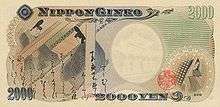
The Genji is also often referred to as "the first novel",[32] though there is considerable debate over this — some of the debate involving whether Genji can even be considered a "novel". Some consider the psychological insight, complexity and unity of the work to qualify it for "novel" status while simultaneously disqualifying earlier works of prose fiction.[33] Others see these arguments as subjective and unconvincing.
Related claims, perhaps in an attempt to sidestep these debates, are that Genji is the "first psychological novel" or "historical novel",[34] "the first novel still considered to be a classic" or other more qualified terms. However, critics have almost consistently described The Tale of Genji as the oldest, first, and/or greatest novel in Japanese literature,[35][36] though enthusiastic proponents may have later neglected the qualifying category of in Japanese literature, leading to the debates over the book's place in world literature. Even in Japan, the Tale of Genji is not universally embraced; the lesser known Ochikubo Monogatari has been proposed as the "world's first full-length novel", even though its author is unknown.[37] Despite these debates, The Tale of Genji enjoys solid respect among the works of literature, and its influence on Japanese literature has been compared to that of Philip Sidney's Arcadia on English literature.[35]
The novel and other works by Lady Murasaki are staple reading material in the curricula of Japanese schools. The Bank of Japan issued the 2000 Yen banknote in her honor, featuring a scene from the novel based on the 12th-century illustrated handscroll. Since a 1 November, 1008 entry in The Diary of Lady Murasaki is the oldest date on which a reference to The Tale of Genji has appeared, November 1st was designated as the official day to celebrate Japanese classics. According to Act on Classics Day, the “classics” that are honored not only include literature, but encompass a wide range of arts such as music, art, traditional performing arts, entertainment, lifestyle art including tea ceremony and flower arrangement and other cultural products.[38]
The names of the chapters became a central element a sort of incense based game called Genjikō, part of the larger practice of Monkō popular among the nobility. In Genjikō, players must match the scents of a series of five incense samples without being told the names of said samples. Each possible combination was matched to a symbol, called a genji-mon, that represented a chapter from the story.[39]
Films and adaptations
The Tale of Genji has been translated into cinematic form several times: first in 1951 by director Kōzaburō Yoshimura, in 1966 by director Kon Ichikawa, and an anime film in 1987 by director Gisaburō Sugii. Sugii's film is not a complete version and basically covers the first 12 chapters, while adding in some psychological motivation that is not explicit in the novel.
An anime television series was made in 2009 by director Osamu Dezaki.and a manga called minamoto kun
The Tale of Genji has been adapted into an opera by Miki Minoru, composed during 1999 and first performed the following year at the Opera Theatre of Saint Louis, with original libretto by Colin Graham (in English), later translated into Japanese by the composer.
Portuguese film director Paulo Rocha made a loose film adaptation of the Genji Monogatari adapted to the 1980s Portuguese context in 1987, O Desejado ou As Montanhas da Lua ("The Desired One or the Mountains of the Moon").[40]
See also
Notes
- ↑ Lyons, Martyn (2011). Books: A Living History. Los Angeles: J. Paul Getty Museum. p. 30.
|access-date=requires|url=(help) - ↑ Birmingham Museum of Art (2010). Birmingham Museum of Art : guide to the collection. [Birmingham, Ala]: Birmingham Museum of Art. p. 49. ISBN 978-1-904832-77-5.
- 1 2 ""The Tale of Genji" - Playboy of the eastern world". The Economist. Retrieved January 9, 2014.
- ↑ Yosano, Akiko
- ↑ The Diary of Lady Murasaki, ed. Richard Bowring, Penguin Classics 2005, p.31, note 41. In his introduction to the text, Bowring discusses its dating which, in any case, is generally accepted by most authorities. Royall Tyler, in his edition of the Tale of Genji cited below, also draws attention to the entry in Murasaki Shikibu's diary: see the Penguin Books edition, 2003, Introduction, p.xvii
- 1 2 3 4 Shikibu, Murasaki; Tyler, Royall (2002). The Tale of Genji. Viking.
- ↑ Seidensticker (1976: xi)
- ↑ Martin, Gary. "When in Rome, do as the Romans do". The Phrase Finder. Retrieved 4 June 2015.
- ↑ Yamagishi (1958: 14)
- ↑ Yamagishi (1958: 14–6)
- ↑ Nihon Koten Bungaku Daijiten (1986: 621–2)
- ↑ "鎌倉後期の源氏物語写本見つかる" (in Japanese). Sankei News. 2008-03-10. Archived from the original on 2008-03-14. Retrieved 2008-03-11.
- ↑ "源氏物語の「別本」、京都・島原の「角屋」で発見" (in Japanese). Yomiuri. 2008-03-10. Archived from the original on 2008-03-14. Retrieved 2008-03-11.
- 1 2 "源氏物語の最古級写本、勝海舟?の蔵書印も…甲南女子大" (in Japanese). Yomiuri. 2008-10-29. Archived from the original on 2008-11-01. Retrieved 2008-10-29.
- ↑ "「千年紀に奇跡」「勝海舟が恋物語とは」源氏物語写本に驚きの声" (in Japanese). Sankei News. 2008-10-29. Archived from the original on August 2, 2009. Retrieved 2008-10-29.
- ↑ "源氏物語:最古の「梅枝巻」写本 勝海舟の蔵書印も" (in Japanese). Mainichi. 2008-10-29. Retrieved 2008-10-29.
- ↑ Walker, James. Big in Japan: "Jakucho Setouchi: Nun re-writes The Tale of Genji", Archived April 26, 2009, at the Wayback Machine. Metropolis. No. 324; Spaeth, Anthony. "Old-Fashioned lover", Time. December 17, 2001.
- ↑ Richard Gunde (2004-04-27). "Genji in Graphic Detail: Manga Versions of the Tale of Genji". UCLA Asia Institute. Retrieved 2006-11-16.
- ↑ 小学館漫画賞:歴代受賞者 (in Japanese). Shogakukan. Retrieved 2007-08-19.
- ↑ Shikibu, Murasaki; Waley, Arthur (1960). The Tale of Genji. Modern Library. Vintage.
- ↑ Shikibu, Murasaki; Seidensticker, Edward (1976). The Tale of Genji. Knopf.
- ↑ Tyler, Royall (2009). The Disaster of the Third Princess: Essays on the tale of Genji. National Library of Australia.
- ↑ "Genji Finished", Time. July 3, 1933.
- ↑ Takatsuka, Masanori. (1970). Brief remarks on some mistranslations in Arthur Waley's Tale of Genji
- 1 2 "Coming to Terms with the Alien". Monumenta Nipponica 58:2
- ↑ "In All Dignity," Time. August 27, 1928.
- ↑ "Braille version of The Tale of Genji completed in 1,000th year 2008" (in Japanese). Yomiuri Shimbun. Archived from the original on 2008-08-25. Retrieved 2009-01-05.
- ↑ Nimura, Janice P (2 December 2001). "Courtly Lust". The New York Times. Retrieved 3 October 2018.
- ↑ Wood, Michael. "A Distant Mirror", Time. March 11, 2002.
- ↑ Ian Buruma, "The Sensualist," New Yorker, July 20, 2015, p. 67.
- ↑ "The Tale of Genji (Tuttle Classics)". Amazon. p. Editorial Reviews. Retrieved 9 January 2015.
- ↑ Tyler, Royall (2003). The Tale of Genji. Penguin Classics. pp. i-ii & xii. ISBN 0-14-243714-X.
- ↑ Ivan Morris, The World of the Shining Prince (1964), p.277
- ↑ Tyler, Royall (2003). The Tale of Genji. Penguin Classics. p. xxvi. ISBN 0-14-243714-X.
- 1 2 Bryan (1930), 65.
- ↑ Kokusai Bunka Shinkokai (1970), 37.
- ↑ Kato (1979), p.160, 163.
- ↑ "Symposium Commemorating Classics Day". MEXT. Retrieved 6 July 2018.
- ↑ Japan Encyclopedia, p. 237, at Google Books
- ↑ O Desejado ou As Montanhas da Lua (1987), on the website on Portuguese cinema of the Universidade da Beira Interior, Covilhã
Bibliography
- Bargen, Doris G (June 1988). "Spirit Possession in the Context of Dramatic Expressions of Gender Conflict: The Aoi Episode of the Genji monogatari". Harvard Journal of Asiatic Studies. 48 (1): 95–130. doi:10.2307/2719274. JSTOR 2719274.
- Bargen, Doris G (June 1991). "The Search for Things Past in the Genji monogatari". Harvard Journal of Asiatic Studies. 51 (1): 199–232. doi:10.2307/2719245. JSTOR 2719245.
- Bargen, Doris G (1997). A Woman's Weapon : Spirit possession in the Tale of Genji. Honolulu, Hi: University of Hawaiʻi Press.
- Bowring, Richard John (1988). Murasaki shikibu, The Tale of Genji. Cambridge ; New York: Cambridge University Press.
- Bryan, J. Ingram (1930). The Literature of Japan. New York: Henry Holt and Company.
- Childs, Margaret H (1999). "The value of vulnerability: Sexual coercion and the nature of love in japanese court of literature". Journal of Asian Studies. 58 (4): 1059–1080. doi:10.2307/2658495. JSTOR 2658495.
- Chisholm, Julianne Kaui (November 1994). "The Steel-belted Radial of Karma: The End of Genji". The Journal of the Association of Teachers of Japanese. 28 (2): 183–93. doi:10.2307/489291. JSTOR 489291.
- De Wolf, Charles (2014). "Glimpses of Genji Through the Looking-Glass of Language". The Transactions of the Asiatic Society of Japan. fifth series, volume 6.
- D'Etcheverry, Charo B (2007). Love after The Tale of Genji : Rewriting the World of the Shining Prince. Cambridge, Mass: Harvard University Press.
- Field, Norma (1987). The Splendor of Longing in the Tale of Genji. Princeton, N.J: Princeton University Press.
- Friday, Karl (Summer 1988). "Teeth and Claws. Provincial Warriors and the Heian Court". Monumenta Nipponica. 43 (2): 153–85. doi:10.2307/2384742. JSTOR 2384742.
- Gatten, Aileen (Spring 1977). "A Wisp of Smoke. Scent and Character in the Tale of Genji". Monumenta Nipponica. 32 (1): 35–48. doi:10.2307/2384070. JSTOR 2384070.
- Gatten, Aileen (June 1981). "The Order of the Early Chapters in the Genji monogatari". Harvard Journal of Asiatic Studies. 41 (1): 5–46. doi:10.2307/2718998. JSTOR 2718998.
- Gatten, Aileen (April 1986). "Weird Ladies: Narrative Strategy in the Genji monogatari". The Journal of the Association of Teachers of Japanese. 21 (1): 29–48.
- Goff, Janet Emily (1991). Noh Drama and the Tale of Genji : The Art of Allusion in Fifteen Classical Plays. Princeton, N.J: Princeton University Press.
- Henitiuk, Valerie (2008). "Going to Bed with Waley: How Murasaki Shikibu Does and Does Not Become World Literature". Comparative Literature Studies. 45 (1): 40–61. doi:10.1353/cls.0.0010.
- Hirota, Akiko (Fall 1997). "The Tale of Genji: From Heian Classic to Heisei Comic". Journal of Popular Culture. 31 (2): 29–68. doi:10.1111/j.0022-3840.1997.00029.x.
- Kamens, Edward B (1993). Approaches to Teaching Murasaki Shikibu's The Tale of Genji. New York: Modern Language Association of America.
- Kato, Shuichi (1979). A History of Japanese Literature: The First Thousand Years. David Chibbett. New York: Kodansha International, Ltd. ISBN 0-87011-491-3.
- Knapp, Bettina L (Spring 1992). "Lady Murasaki Shikibu's the Tale of Genji: Search for the Mother". Symposium. 46 (1): 34–48. doi:10.1080/00397709.1992.10733759.
- Kornicki, P. F., "Unsuitable Books for Women? "Genji Monogatari" and "Ise Monogatari" in Late Seventeenth-Century Japan", Monumenta Nipponica, Vol. 60, No. 2 (Summer, 2005), pp. 147–193, Sophia University, JSTOR
- Kokusai Bunka Shinkokai, ed. (1970). Introduction to Classic Japanese Literature. Greenwood Printing. ISBN 0-8371-3118-9.
- McCormick, Melissa (2003). "Genji Goes West: The 1510 "Genji Album" and the Visualization of Court and Capital". The Art Bulletin. 85: 54–85. doi:10.2307/3177327. JSTOR 3177327.
- McCullough, William H (1967). "Japanese Marriage Institutions in the Heian Period". Harvard Journal of Asiatic Studies. 27: 103–167. doi:10.2307/2718385. JSTOR 2718385.
- Morris, Ivan I (1964). The World of the Shining Prince: Court Life in Ancient Japan. New York: Kodansha International.
- Morris, Ivan I (1971). The Tale of Genji Scroll [Genji monogatari emaki]. Tokyo: Kodansha International.
- Mostow, Joshua S (Autumn 1992). "Painted Poems, Forgotten Words. Poem-Pictures and Classical Japanese Literature". Monumenta Nipponica. 47 (3): 323–346. doi:10.2307/2385102. JSTOR 2385102.
- Mostow, Joshua S (April 1999). ""Picturing" in The Tale of Genji". The Journal of the Association of Teachers of Japanese. 33 (1): 1–25. doi:10.2307/489628. JSTOR 489628.
- Murase, Miyeko (1983). Iconography of the Tale of Genji : Genji monogatari ekotoba. New York: Weatherhill.
- Murase, Miyeko (2001). The Tale of Genji : Legends and Paintings. New York: G. Braziller.
- Nickerson, Peter (Winter 1993). "The Meaning of Matrilocality. Kinship, Property, and Politics in Mid-Heian". Monumenta Nipponica. 48 (4): 429–67. doi:10.2307/2385292. JSTOR 2385292.
- Nihon Koten Bungaku Daijiten: Kan'yakuban. Tokyo: Iwanami Shoten. 1986. ISBN 4-00-080067-1.
- Okada, H. Richard (1991). Figures of Resistance : Language, Poetry, and Narrating in the Tale of Genji and Other Mid-Heian Texts. Durham: Duke University Press.
- Pekarik, Andrew (1982). Ukifune : Love in the tale of genji. New York: Columbia University Press.
- Puette, William J (1983). Guide to the Tale of Genji by Murasaki Shikibu. Rutland, Vt: C.E. Tuttle.
- Rowley, Gillian Gaye (2000). Yosano Akiko and the Tale of Genji. . Ann Arbor, MI: Center for Japanese Studies, University of Michigan.
- Seidensticker, Edward G. (1976). The Tale of Genji. 1. Turtle Publishing. ISBN 978-4-8053-0919-3.
- Seidensticker, Edward G. (1976). The Tale of Genji. 2. Turtle Publishing. ISBN 978-4-8053-0920-9.
- Sestili Daniele (1996). Musica e danza del principe Genji. Le arti dello spettacolo nell’antico Giappone. Lucca: LIM,
- Shirane, Haruo (December 1985). "The Aesthetics of Power: Politics in the Tale of Genji". Harvard Journal of Asiatic Studies. 45 (2): 615–47. doi:10.2307/2718974. JSTOR 2718974.
- Shirane, Haruo (1987). The Bridge of Dreams : A Poetics of the Tale of Genji. Stanford, Calif.: Stanford University Press.
- Shirane, Haruo (2008). Envisioning the Tale of Genji: Media, Gender, and Cultural Production. New York: Columbia University Press.
- Stevenson and Ho, Barbara and Cynthia O (2000). Crossing the Bridge : Comparative Essays on Medieval European and Heian Japanese Women Writers. New York: Palgrave.
- Tyler, Royall (1999). ""I Am I": Genji and Murasaki". Monumenta Nipponica. 54 (4): 435–480. doi:10.2307/2668318. JSTOR 2668318.
- Tyler, Royall (2001). The Tale of Genji. New York: Viking.
- Tyler, Royall (March 2002). "Marriage, Rank and Rape in The Tale of Genji". Intersections: Gender, History and Culture in the Asian Context. 7.
- Tyler, Royall and Susan (2002). "The Possession of Ukifune". Asiatica Venetiana. 5: 177–209.
- Tyler, Royall (2003). "Rivalry, Triumph, Folly, Revenge: A Plot Line through the Tale of Genji". Journal of Japanese Studies. 29 (2): 251–87.
- Ury, Marian (1988). "A Heian Note on the Supernatural". The Journal of the Association of Teachers of Japanese. 22 (2): 189–94. doi:10.2307/488941. JSTOR 488941.
- Lawrence, Hollendaisde (1958). Nihon Koten Bungaku Taikei 14: Genji Monogatari 1 (in Japanese). Tōkyō: Iwanami Shoten. ISBN 4-00-060014-1.
- Yoda, Tomiko (December 1999). "Fractured Dialogues: Mono no aware and Poetic Communication in the Tale of Genji". Harvard Journal of Asiatic Studies. 59 (2): 523–57. doi:10.2307/2652721. JSTOR 2652721.
External links
| Wikimedia Commons has media related to The Tale of Genji. |
- The Tale of Genji -- Oxford Text Archive A complete English translation of the work, free for non-commercial use, Edward G. Seidensticker's translation.
- The Tale of Genji, 1654 Library of Congress, Asian Division. The edition in the Library of Congress is a complete and well-preserved set including the complete main text (54 volumes) of Tale of Genji, also Meyasu (3 volumes, commentary on key words and phrases in the text, Keizu (genealogy), Yamaji no tsuyu (a sequel to the work by a later author), and Hikiuta (index).
- Japanese Literature - Including Selections from Genji Monogatari and Classical Poetry and Drama of Japan Contains the 1882 Suematsu translation of the first 17 chapters of The Tale of Genji, with an introduction and notes.
- The Texts of Genji Monogatari Original text, romanized version, and modern Japanese translation of The Tale of Genji at the University of Virginia Library.
- Tale of the Genji woodcuts Woodcut illustrations and accompanying excerpts at the UNESCO Global Heritage Pavilion.
- The Picture Scroll of The Tale of Genji Some scans of the Genji Monogatari Emaki (Tale of Genji Scroll). Only about half of the images are from the twelfth-century scroll; they are the darker colored, more faded images.
- The Tale of Genji A photographic guide to The Tale of Genji.
- The Tale of Genji Audiobooks Japanese reading of 7 of 54 chapters from the original text, mp3 files.
- Japan Finance Minister Announces Kyoto Coin Design with The Tale of Genji Theme The Kyoto Prefecture commemorative coin set for release in October 2008 features a scene from The Tale of Genji.
- Carving of Picture Scroll of Genji monogatari Paper carvings by Noda Kazuko reproducing the 18 extant illustrations of the 13th-century Genji monogatari emaki.
- Ohmi Gallery A nice collection of Ukiyo-e and Shin-hanga, including illustrations of The Tale of Genji by such artists as Ebina Masao and Utagawa Kunisada.
- Tale of Genji Scroll 18th century anonymous artist Available at Dartmouth College, it covers the first 16 chapters of the tale.
- The Tale of Genji by Miyata Masayuki Paper cuts by renowned artist Miyata Masayuki.
- World Digital Library presentation of 源氏物語 Genji monogatari: Volume One, Kiritsubo. Library of Congress. Primary source moveable type book. 1596-1615, first printed edition of the world's first great novel.
